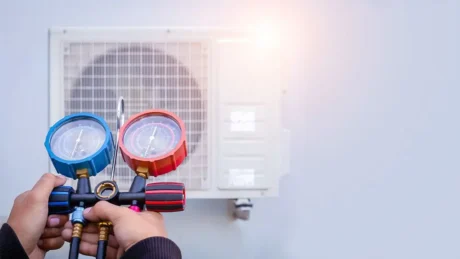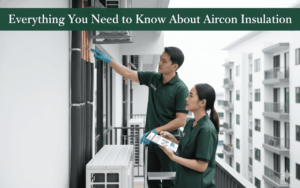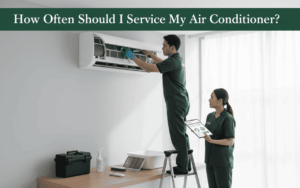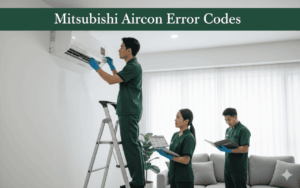Is your aircon blowing warm air instead of the cool, refreshing breeze you desperately need in Singapore’s sweltering heat? Few things are more frustrating than an AC not cooling when you need it most. Before you call for help, there might be some simple fixes you can try yourself.
In this comprehensive guide, we’ll walk through every possible reason why your AC is not cooling properly – from quick DIY fixes to problems that need professional attention. By the end, you’ll know exactly what’s happening with your AC cooling problem and what steps to take next.
Essential First Checks Before Panicking
If your AC is not giving cool air, start with these basic checks that might solve your cooling issues in minutes:
Is It Getting Power?
It sounds obvious, but power issues are surprisingly common culprits when your AC not working:
- Check your circuit breaker – Has it tripped? Simply resetting the breaker might restore cooling instantly.
- Verify the power plug is securely connected to the wall outlet. Vibrations can sometimes loosen the connection.
- Confirm there’s no neighborhood power outage affecting your building.
Have You Set Your Thermostat Correctly?
Thermostat problems are among the most frequent reasons for AC not cooling:
- Check the mode setting – Is it actually set to “Cool” and not “Fan Only” or “Dry”?
- Verify the temperature setting is lower than the current room temperature. If the room is already at or below your set temperature, the AC won’t engage cooling.
- Replace thermostat batteries if needed. Dead batteries can cause erratic behavior or complete unresponsiveness.
When Did You Last Clean Your Air Filters?
In Singapore’s humid and dusty conditions, filters can become clogged incredibly quickly:
- Open the front panel of your indoor unit and remove the filter(s).
- Inspect for dust buildup – if they look dirty or clogged, this could be your entire AC cooling problem!
- Remember: In Singapore’s climate, filters may need cleaning every 2-4 weeks, not every few months as in drier climates – check our guide on different types of aircon services.
Is Anything Blocking Airflow?
If your split AC not cooling but fan is running, airflow blockages might be the culprit:
- Check indoor vents – Move any furniture, curtains, or decorations blocking air inlets or outlets.
- Inspect the outdoor unit – Clear away any plants, leaves, or debris within at least 60cm (2 feet) of the condenser unit.
- Ensure supply vents in rooms are open and unobstructed.
Common Reasons Your AC Isn’t Cooling (And How to Fix Them)
If the basic checks didn’t solve your problem, here are the likely reasons for AC not cooling enough:
1. Dirty or Clogged Air Filters

What’s happening: When air filters get clogged with dust and debris, they severely restrict airflow through your system. Less air passing over the cold evaporator coils means less cool air circulating back into the room. In extreme cases, the reduced airflow can even cause the evaporator coil to freeze over!
How you’ll notice it:
- Weak airflow from the vents
- AC takes much longer to cool the room
- Uneven temperatures throughout the space
- Higher electricity bills
- Possibly a musty odor (if mold has developed)
- Ice or frost visible on the indoor unit
How to fix it:
- Remove the filters from your indoor unit
- For washable filters, rinse thoroughly under water (mild soap optional)
- Let them dry completely before reinstalling
- Consider vacuuming the filter first to remove loose debris
- Replace non-washable filters with new ones
Prevention tip: In Singapore’s climate, clean your filters every 2-4 weeks. Mark it in your calendar – this single habit can prevent numerous AC cooling problems!
2. Low Refrigerant Levels (Refrigerant Leak)

What’s happening: Refrigerant is the lifeblood of your AC system, absorbing heat from your home and releasing it outside. If levels are too low (usually due to a leak), your air conditioner not cooling effectively. Remember: refrigerant isn’t supposed to be “used up” during normal operation – low levels almost always mean there’s a leak.
How you’ll notice it:
- Air from vents feels warm or only slightly cool
- AC runs constantly but never reaches the set temperature
- Ice or frost forming on refrigerant lines (copper pipes) or the indoor unit
- Hissing or bubbling sounds near AC components
- Higher energy bills despite poor cooling
- Water dripping after the unit is turned off (melting ice)
How to fix it:
- This is NOT a DIY fix! Refrigerant requires specialized equipment, training, and licensing.
- Contact a qualified aircon technician to detect and repair the leak
- Once repaired, the system will need to be evacuated and recharged with the correct amount of refrigerant.
- Beware of technicians who just want to “top up” refrigerant without fixing the leak – this is only a temporary (and environmentally harmful) solution.
Prevention tip: Schedule regular professional maintenance to catch small leaks before they become major aircon gas leak problems.
3. Dirty Condenser Coils (Outdoor Unit)

What’s happening: The outdoor condenser coils release the heat your AC removes from your home. When these coils get coated with dirt, dust, leaves, and urban grime, they can’t efficiently dissipate heat. This forces your entire system to work harder while delivering less cooling.
How you’ll notice it:
- Declining cooling performance over time
- AC runs longer than usual to reach target temperature
- Outdoor unit seems to be working harder or feels unusually hot
- Increasing energy bills
- Visible dirt and debris on the outdoor unit’s fins
How to fix it:
- Turn off power to the AC at the breaker box
- Gently brush away loose debris using a soft brush
- Carefully rinse the coils with a garden hose (low pressure, from inside out)
- Avoid bending the delicate fins
- For heavily soiled coils, consider professional aircon servicing with specialized solutions
Prevention tip: Maintain at least 60cm (2 feet) of clear space around your outdoor unit and consider installing it in a location protected from excessive dust and debris where possible.
4. Dirty Evaporator Coils (Indoor Unit)

What’s happening: The evaporator coils inside your indoor unit are where the actual cooling happens. When they become coated with dust and grime, they can’t effectively absorb heat from your room’s air. The insulating layer of dirt prevents efficient heat transfer, and in severe cases, can cause the coils to freeze over completely.
How you’ll notice it:
- Weak cooling despite the system running
- Musty or moldy smell from the vents
- Visible ice or frost forming on the indoor unit
- Water leaking or dripping from the indoor unit
- AC runs continuously without reaching set temperature
How to fix it:
- This typically requires professional service
- A thorough chemical wash or chemical overhaul will clean the coils and kill any mold/bacteria
- The best DIY prevention is regular filter cleaning, which prevents dust from reaching the coils in the first place
Why it happens in Singapore: High humidity creates a perfect environment for mold growth on the constantly damp evaporator coils, making this essential aircon part especially vulnerable.
5. Clogged Drain Line

What’s happening: As your AC cools, it also dehumidifies, pulling moisture from the air. This condensation drips into a drain pan and exits through a drain line. Over time, this line can become clogged with algae, mold, slime, and debris. When blocked, water backs up and eventually overflows.
How you’ll notice it:
- Water dripping or leaking from your indoor unit
- Water stains on the wall or ceiling near the unit
- Musty odors due to stagnant water
- Visible mold or algae growth around the drain opening
- In units with safety switches, the AC might shut down entirely
How to fix it:
- DIY option: Use a wet/dry vacuum at the drain exit to suction out the blockage
- For accessible drain lines: Pour a solution of equal parts water and vinegar down the line
- For persistent clogs: Call a professional who has specialized tools like high-pressure nitrogen to clear the entire line
Singapore note: High humidity means Singapore AC units produce a significant amount of condensate water, making aircon leaking water issues particularly common here.
6. Faulty Thermostat
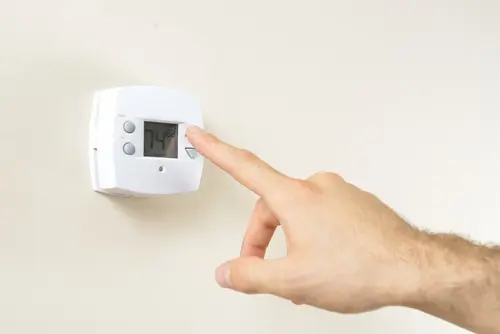
What’s happening: Your thermostat is the control center for your entire AC system. It can fail electronically or mechanically, losing its ability to accurately sense temperature or send proper signals to your AC unit.
How you’ll notice it:
- AC doesn’t turn on when it should, or doesn’t turn off when set temperature is reached
- System blows warm air despite being set to cool
- Room temperature never matches display temperature
- Display shows incorrect readings or goes blank
- AC runs in short, frequent bursts or runs continuously without reaching the set point
How to fix it:
- Double-check all settings and batteries first
- Try resetting the thermostat according to manufacturer instructions
- Reset the entire AC system by turning off power at the circuit breaker for a few minutes
- Ensure the thermostat isn’t located in direct sunlight or near heat sources
- If problems persist, a technician will need to test and potentially replace the thermostat
Prevention tip: Consider upgrading to a more reliable digital thermostat if you have an older model prone to inconsistency.
7. Incorrect AC Size
What’s happening: If your air conditioner is too small for your space, it will run constantly but never adequately cool the room. If it’s too large, it will cool too quickly but shut off before properly dehumidifying, leaving the room cold but uncomfortably damp.
How you’ll notice it:
- Undersized unit: Runs constantly, never feels cool enough (especially during hottest parts of the day)
- Oversized unit: Room feels cool but damp/sticky/humid, AC turns on and off frequently in short bursts
- Either way: High energy bills due to inefficient operation
How to fix it:
- Unfortunately, there’s no DIY fix for incorrect sizing
- You can mitigate symptoms by improving insulation, using blinds/curtains to block solar heat, and ensuring the existing unit is well-maintained
- The only real solution is replacing the unit with one of the appropriate capacity, which requires professional assessment
Singapore tip: For HDB flats, general guidelines suggest around 9,000 BTU for a common room, 12,000 BTU for a master bedroom, and potentially 18,000 BTU or more for a living room – contact professional aircon services for proper sizing.
When to Call the Professionals: Serious AC Problems
Some air conditioning problems go beyond simple DIY fixes. If you’re wondering what to do if AC is not cooling after trying the above solutions, here are serious issues requiring professional attention:
1. Compressor Failure
What it is: The compressor is the heart of your AC system, responsible for circulating refrigerant. When it fails, cooling capacity is severely compromised or lost entirely.
Warning signs:
- Loud, unusual noises from the outdoor unit (rattling, rumbling, grinding)
- AC runs but blows only warm or room-temperature air
- Unit struggles to start, sometimes vibrating or shaking violently
- Circuit breaker trips repeatedly when the system tries to turn on
- Refrigerant leaking specifically around the compressor area
What to do: Call a professional aircon repair service immediately. Compressor replacement is one of the most expensive AC repairs, and depending on the age of your system, it might be more cost-effective to replace the entire outdoor unit or the complete AC system.
2. Capacitor Failure
What it is: Capacitors work like temporary batteries, providing the electrical boost needed to start and run the motors in your AC system.
Warning signs:
- AC tries to start but fails, often with a humming or buzzing sound
- Unit starts but shuts off shortly afterward
- Noticeable delay before the AC kicks in after the thermostat calls for cooling
- Clicking sounds from the outdoor unit
- Visible signs of damage on the capacitor itself (swollen or bulging casing, leaking oily fluid)
What to do: Contact a qualified technician. Never attempt to handle capacitors yourself, as they can store a dangerous electrical charge even when the power is off – learn more about critical aircon parts.
3. Electrical Control Board Failure
What it is: The control board is the central intelligence of your AC system, processing signals from the thermostat and controlling various components.
Warning signs:
- AC system behaves erratically or unpredictably
- Specific components not working (e.g., fan runs but compressor doesn’t engage)
- Unit completely dead or unresponsive to thermostat
- Unusual noises like clicking or buzzing when the unit should be off
- Blinking LED lights or error codes displayed on the unit
What to do: A professional aircon technician needs to diagnose and repair this issue, as it involves complex electronic components.
4. Fan Motor Issues
What it is: AC systems have two important fans: the indoor blower fan and the outdoor condenser fan. If either fails, cooling is compromised.
Warning signs for indoor blower failure:
- Very weak or no airflow from supply vents
- Strange noises (humming, grinding, squealing) from indoor unit
- Evaporator coil freezing up due to lack of airflow
Warning signs for outdoor fan failure:
- Fan blades in outdoor unit not spinning when AC is running
- Outdoor unit overheating
- Poor or no cooling indoors
- Unusual noises from outdoor unit
What to do: Call a technician to diagnose and replace the affected motor. Note that outdoor fan motor failure is particularly urgent, as the resulting heat buildup can quickly damage the much more expensive compressor if not addressed promptly – learn about key aircon components.
Singapore-Specific AC Considerations
Living in Singapore creates unique challenges for air conditioning systems that residents should be aware of:
The Humidity Factor
Singapore’s consistently high humidity (often exceeding 70%) significantly impacts how your AC performs:
- Increased workload: Your AC must both cool AND dehumidify, making it work harder than in drier climates
- Mold risks: Constant moisture makes AC systems particularly susceptible to mold growth
- Condensation issues: Singapore AC units produce more condensate water, increasing the likelihood of drain clogs
- Solution tips:
- Ensure your AC is correctly sized (oversized units exacerbate humidity problems)
- Consider using the “Dry” mode setting when humidity is your primary concern
- Regular maintenance is even more critical in humid environments
Local Regulations and Safety Requirements
In Singapore, AC maintenance isn’t just about comfort, it’s a legal obligation:
- Owner responsibility: Homeowners are legally responsible for regular inspection and maintenance of their AC units
- Safety consequences: If an AC unit or its support falls due to lack of maintenance, owners can face substantial fines (up to S$10,000) and potentially imprisonment
- Installation standards: Only Trained Air-con Unit Installers (TAIs) registered with BCA are permitted to install external AC units
- Maintenance checks: BCA recommends checking structural supports for corrosion or wear at least once every six months
Common AC Types in Singapore Homes
Understanding what type of system you have helps with troubleshooting when your AC cooling not working:
- Split systems: The most common in HDB flats, with separate indoor and outdoor units. Can be single-split (one indoor unit) or multi-split (multiple indoor units connected to one outdoor unit)
- Window air conditioners: Self-contained units installed in window openings, less common in newer installations
- Portable air conditioners: Standalone units that can be moved between rooms, generally less efficient than other types
- Brand landscape: Daikin, Mitsubishi Electric, Panasonic, and LG are popular brands in Singapore – find reliable aircon services for these brands
Why Regular Maintenance Is Worth Every Dollar
If you’re wondering why my AC is not cooling properly, regular maintenance is likely the answer:
Energy Savings
- Regular maintenance can reduce energy usage by 5-15%
- Just keeping air filters clean yields 5-15% energy savings
- In Singapore’s climate, where AC runs almost year-round, these savings add up quickly!
Extended Lifespan and Reliability
- Regular servicing can extend your AC’s lifespan by up to 50%
- Up to 85% of AC repairs are linked to lack of proper maintenance
- Routine maintenance can reduce the risk of breakdowns by as much as 95%
Improved Comfort and Health
- Well-maintained units provide more consistent temperatures and better humidity control
- Clean filters, coils, and drain lines are crucial for good indoor air quality
- Regular cleaning prevents the circulation of dust, allergens, and mold
What Professional Maintenance Typically Includes
Every 6 months, your aircon servicing should cover:
- Cleaning/replacing air filters
- Cleaning both indoor and outdoor coils
- Clearing condensate drain line and pan
- Checking refrigerant levels and pressures
- Inspecting electrical connections and components
- Testing overall system operation
- Inspecting structural supports (especially important in Singapore)
To learn more about what different types of aircon servicing you should be doing, read our guide on types of aircon servicing.
Brand-Specific Troubleshooting Tips
If your AC is not cooling enough, different brands may display unique error patterns. Here’s a quick guide to some popular brands in Singapore:
Daikin
- Error codes: Can often be retrieved by pointing the remote at the unit and pressing the “Check” or “Inspection” button for about 5 seconds
- Common codes: A1 (Indoor PCB issue), A3 (Drain level issue), U4 (Communication error), E5 (Compressor motor overload)
- Reset trick: Try turning the unit off with the power button, waiting, and turning it back on, or cycling the circuit breaker (off for 20 mins, then on)
Mitsubishi Electric
- Common issues: If my AC is not cooling, it’s often attributed to insufficient refrigerant or dirty components
- Error diagnosis: Errors indicated by patterns of blinking lights on the indoor unit or retrieved via a “CHECK” button on the remote
- Look for: Error codes like E1 (communication error) or F1 (indoor unit problem)
Panasonic
- Error indicators: Yellow/Green blinking often relates to dirty filters; Red blinking usually signals more critical problems; Blue blinking might indicate refrigerant issues
- Common codes: H11 (Communication error), H99 (Indoor unit clog/filter issue)
- Basic checks: Verify temperature setting (16°C is coldest), ensure outdoor unit is running, check filter cleanliness
LG
- Support approach: LG primarily directs users to official support channels for troubleshooting
- Resources: Check LG’s website for model-specific manuals and troubleshooters
- General principles: When your AC not giving cool air, standard troubleshooting (power, filters, settings) applies to LG units as well
Conclusion: What To Do When AC Is Not Cooling
In Singapore’s hot and humid climate, a properly functioning air conditioner isn’t a luxury, it’s essential for comfort and productivity. When you’re facing reasons for AC not cooling, it’s usually due to one of the issues we’ve covered.
Remember these key takeaways:
- Start with the simplest checks first: power, thermostat settings, clean filters, and clear airflow paths
- Regular maintenance is your best defense against cooling problems
- Singapore’s high humidity makes diligent AC care even more critical
- Know when to call in the professionals, especially for refrigerant, electrical, or major component issues
- Keep up with legally required safety inspections for outdoor units
By following this troubleshooting guide for when your air conditioner is not cooling, you’ll stay cooler, save money, and extend the life of your AC unit. And if you’re ever in doubt, consulting with a qualified aircon professional can save you time, frustration, and potentially expensive repairs down the road.
About Helpling
Helpling is a super app for household services. As a home service company, we work with, and train service professionals to provide a wide range of services such as home cleaning service, aircon service, carpet cleaning, and mattress cleaning.
Beyond that, we also provide solutions for other household needs such as handyman, plumbing, and gardening service, all of which can be seamlessly and efficiently booked through our app or, for existing customers, via their personal Home Advisors.
